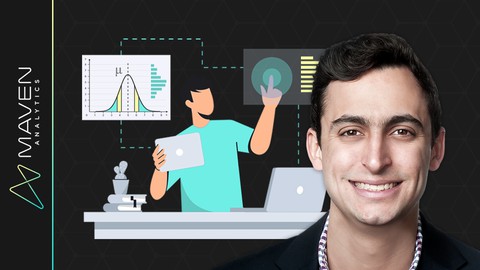
Microsoft Excel: Essential Statistics for Data Analysis
Microsoft Excel: Essential Statistics for Data Analysis, available at $94.99, has an average rating of 4.74, with 137 lectures, 25 quizzes, based on 1094 reviews, and has 8772 subscribers.
You will learn about Learn powerful statistics tools and techniques for data analysis & business intelligence Understand how to apply foundational statistics concepts like the central limit theorem and empirical rule Explore data with descriptive statistics, including probability distributions and measures of variability & central tendency Model data and make estimates using probability distributions and confidence intervals Make data-driven decisions and draw conclusions with hypothesis testing Use linear regression models to explore variable relationships and make predictions This course is ideal for individuals who are Aspiring data professionals who want an intuitive, beginner-friendly introduction to the world of statistics or Business intelligence professionals who want to make confident, data-driven decisions or Anyone using data to make assumptions, estimates or predictions on the job or Students looking to learn powerful, practical skills with unique, hands-on projects and demos It is particularly useful for Aspiring data professionals who want an intuitive, beginner-friendly introduction to the world of statistics or Business intelligence professionals who want to make confident, data-driven decisions or Anyone using data to make assumptions, estimates or predictions on the job or Students looking to learn powerful, practical skills with unique, hands-on projects and demos.
Enroll now: Microsoft Excel: Essential Statistics for Data Analysis
Summary
Title: Microsoft Excel: Essential Statistics for Data Analysis
Price: $94.99
Average Rating: 4.74
Number of Lectures: 137
Number of Quizzes: 25
Number of Published Lectures: 137
Number of Published Quizzes: 25
Number of Curriculum Items: 162
Number of Published Curriculum Objects: 162
Original Price: $129.99
Quality Status: approved
Status: Live
What You Will Learn
- Learn powerful statistics tools and techniques for data analysis & business intelligence
- Understand how to apply foundational statistics concepts like the central limit theorem and empirical rule
- Explore data with descriptive statistics, including probability distributions and measures of variability & central tendency
- Model data and make estimates using probability distributions and confidence intervals
- Make data-driven decisions and draw conclusions with hypothesis testing
- Use linear regression models to explore variable relationships and make predictions
Who Should Attend
- Aspiring data professionals who want an intuitive, beginner-friendly introduction to the world of statistics
- Business intelligence professionals who want to make confident, data-driven decisions
- Anyone using data to make assumptions, estimates or predictions on the job
- Students looking to learn powerful, practical skills with unique, hands-on projects and demos
Target Audiences
- Aspiring data professionals who want an intuitive, beginner-friendly introduction to the world of statistics
- Business intelligence professionals who want to make confident, data-driven decisions
- Anyone using data to make assumptions, estimates or predictions on the job
- Students looking to learn powerful, practical skills with unique, hands-on projects and demos
This is a hands-on, project-based course designed to help you learn and apply essential statistics concepts for data analysis and business intelligence.
Our goal is to simplify and demystify the world of statistics using familiar spreadsheet tools like Microsoft Excel, and empower everyday people to understand and apply these tools and techniques – even if you have absolutely no background in math or stats!
We’ll start by discussing the role of statistics in business intelligence, the difference between sample and population data, and the importance of using statistical techniques to make smart predictions and data-driven decisions.
Next we’ll explore our data using descriptive statistics and probability distributions, introduce the normal distribution and empirical rule, and learn how to apply the central limit theorem to make inferences about populations of any type.
From there we’ll practice making estimates with confidence intervals, and using hypothesis tests to evaluate assumptions about unknown population parameters. We’ll introduce the basic hypothesis testing framework, then dive into concepts like null and alternative hypotheses, t-scores, p-values, type I vs. type II errors, and more.
Last but not least, we’ll introduce the fundamentals of regression analysis, explore the difference between correlation and causation, and practice using basic linear regression models to make predictions using Excel’s Analysis Toolpak.
Throughout the course, you’ll play the role of a Recruitment Analyst for Maven Business School. Your goal is to use the statistical techniques you’ve learned to explore student data, predict the performance of future classes, and propose changes to help improve graduate outcomes.
You’ll also practice applying your skills to 5 real-world BONUS PROJECTS, and use statistics to explore data from restaurants, medical centers, pharmaceutical companys, safety teams, airlines, and more.
COURSE OUTLINE:
-
Why Statistics?
-
Discuss the role of statistics in the context of business intelligence and decision-making, and introduce the statistics workflow
-
-
Understanding Data with Descriptive Statistics
-
Understand data using descriptive statistics in Excel, including frequency distributions and measures of central tendency & variability
-
PROJECT #1: Maven Pizza Parlor
-
-
Modeling Data with Probability Distributions
-
Model data with probability distributions, and use the normal distribution to calculate probabilities and make value estimates using Excel formulas
-
PROJECT #2: Maven Medical Center
-
-
The Central Limit Theorem
-
Introduce the Central Limit Theorem, which leverages the normal distribution to make inferences on populations with any distribution
-
-
Making Estimates with Confidence Intervals
-
Make estimates with confidence intervals, which use sample statistics to define a range where an unknown population parameter likely lies
-
PROJECT #3: Maven Pharma
-
-
Drawing Conclusions with Hypothesis Tests
-
Draw conclusions with hypothesis tests, which let you evaluate assumptions about population parameters using sample statistics
-
PROJECT #4: Maven Safety Council
-
-
Making Predictions with Regression Analysis
-
Make predictions with regression analysis, and estimate the values of a dependent variable via its relationship with independent variables
-
PROJECT #5: Maven Airlines
-
Join today and get immediate, lifetime access to the following:
-
7.5 hours of high-quality video
-
Statistics for Data Analysis PDF ebook (150+ pages)
-
Downloadable Excel project files & solutions
-
Expert support and Q&A forum
-
30-day Udemy satisfaction guarantee
If you’re a data analyst, data scientist, business intelligence professional, or anyone looking to use statistics to make smart, data-driven decisions, this course is for you!
Happy learning!
-Enrique Ruiz (Lead Statistics & Excel Instructor,Maven Analytics)
__________
Looking for our full course library? Search “Maven Analytics” to browse our full collection of Excel, Power BI, SQL, Tableau, Python, Alteryx & Machine Learningcourses!
See why our Excel courses are some of the TOP-RATED on Udemy:
“At the first part I just said to myself, ‘Wow, Excel is capable of that? It’s amazing!’ Then at the second part I told myself ‘This guy is doing magic!’, and now I feel like I’m capable of doing the same. I can’t wait to dive into the other courses!”
– Judit B.
“Excellent from start to finish. I picked up a bunch of techniques that will be useful in the workplace, from new chart templates to some very cool advanced visualizations. I loved all of it!”
– Robert C.
“Excellent material that I apply to my daily use of Excel. I consider myself an Excel professional, yet I picked up dozens of new tips and techniques. Wonderful course, well-presented and well-explained.”
– Jeffrey P.
__________
Course Curriculum
Chapter 1: Getting Started
Lecture 1: Course Structure & Outline
Lecture 2: READ ME: Important Notes for New Students
Lecture 3: DOWNLOAD: Course Resources
Lecture 4: Setting Expectations
Lecture 5: The Course Project
Lecture 6: Helpful Resources
Chapter 2: Why Statistics?
Lecture 1: Section Intro
Lecture 2: Why Statistics?
Lecture 3: Populations & Samples
Lecture 4: The Statistics Workflow
Chapter 3: Understanding Data with Descriptive Statistics
Lecture 1: Section Intro
Lecture 2: Descriptive Statistics Basics
Lecture 3: Types of Variables
Lecture 4: Types of Descriptive Statistics
Lecture 5: Categorical Frequency Distributions
Lecture 6: Numerical Frequency Distributions
Lecture 7: Histograms
Lecture 8: ASSIGNMENT: Frequency Distributions
Lecture 9: SOLUTION: Frequency Distributions
Lecture 10: Mean, Median, and Mode
Lecture 11: Left & Right Skew
Lecture 12: ASSIGNMENT: Measures of Central Tendency
Lecture 13: SOLUTION: Measures of Central Tendency
Lecture 14: Min, Max & Range
Lecture 15: Interquartile Range
Lecture 16: Box & Whisker Plots
Lecture 17: Variance & Standard Deviation
Lecture 18: PRO TIP: Coefficient of Variation
Lecture 19: ASSIGNMENT: Measures of Variability
Lecture 20: SOLUTION: Measures of Variability
Lecture 21: Key Takeaways
Chapter 4: PROJECT #1: Maven Pizza Parlor
Lecture 1: PROJECT BRIEF: Maven Pizza Parlor
Lecture 2: SOLUTION: Maven Pizza Parlor
Chapter 5: Modeling Data with Probability Distributions
Lecture 1: Section Intro
Lecture 2: Probability Distribution Basics
Lecture 3: Types of Probability Distributions
Lecture 4: The Normal Distribution
Lecture 5: Z Scores
Lecture 6: The Empirical Rule
Lecture 7: ASSIGNMENT: Normal Distributions
Lecture 8: SOLUTION: Normal Distributions
Lecture 9: Excel's Normal Distribution Functions
Lecture 10: Calculating Probabilities with the Normal Distribution
Lecture 11: The NORM.DIST Function
Lecture 12: The NORM.S.DIST Function
Lecture 13: ASSIGNMENT: Calculating Probabilities
Lecture 14: SOLUTION: Calculating Probabilities
Lecture 15: PRO TIP: Plotting the Normal Curve
Lecture 16: Estimating X or Z Values with the Normal Distribution
Lecture 17: The NORM.INV Function
Lecture 18: The NORM.S.INV Function
Lecture 19: ASSIGNMENT: Estimating Values
Lecture 20: SOLUTION: Estimating Values
Lecture 21: Key Takeaways
Chapter 6: PROJECT #2: Maven Medical Center
Lecture 1: PROJECT BRIEF: Maven Medical Center
Lecture 2: SOLUTION: Maven Medical Center
Chapter 7: The Central Limit Theorem
Lecture 1: Section Intro
Lecture 2: The Central Limit Theorem
Lecture 3: DEMO: Proving the Central Limit Theorem
Lecture 4: Standard Error
Lecture 5: Implications of the Central Limit Theorem
Lecture 6: Applications of the Central Limit Theorem
Lecture 7: Key Takeaways
Chapter 8: Making Estimates with Confidence Intervals
Lecture 1: Section Intro
Lecture 2: Confidence Intervals Basics
Lecture 3: Confidence Level
Lecture 4: Margin of Error
Lecture 5: DEMO: Calculating Confidence Intervals
Lecture 6: The CONFIDENCE.NORM Function
Lecture 7: ASSIGNMENT: Confidence Intervals
Lecture 8: SOLUTION: Confidence Intervals
Lecture 9: Types of Confidence Intervals
Lecture 10: T Distribution
Lecture 11: Excel's T Distribution Functions
Lecture 12: Confidence Intervals with the T Distribution
Lecture 13: ASSIGNMENT: Confidence Intervals (T Distribution)
Lecture 14: SOLUTION: Confidence Intervals (T Distribution)
Lecture 15: Confidence Intervals for Proportions
Lecture 16: ASSIGNMENT: Confidence Intervals (Proportions)
Instructors
-
Maven Analytics
Empowering everyday people with life-changing data skills -
Enrique Ruiz
Certified Microsoft Excel Expert
Rating Distribution
- 1 stars: 0 votes
- 2 stars: 2 votes
- 3 stars: 56 votes
- 4 stars: 312 votes
- 5 stars: 724 votes
Frequently Asked Questions
How long do I have access to the course materials?
You can view and review the lecture materials indefinitely, like an on-demand channel.
Can I take my courses with me wherever I go?
Definitely! If you have an internet connection, courses on Udemy are available on any device at any time. If you don’t have an internet connection, some instructors also let their students download course lectures. That’s up to the instructor though, so make sure you get on their good side!
You may also like
- Best Video Editing Courses to Learn in February 2025
- Best Music Production Courses to Learn in February 2025
- Best Animation Courses to Learn in February 2025
- Best Digital Illustration Courses to Learn in February 2025
- Best Renewable Energy Courses to Learn in February 2025
- Best Sustainable Living Courses to Learn in February 2025
- Best Ethical AI Courses to Learn in February 2025
- Best Cybersecurity Fundamentals Courses to Learn in February 2025
- Best Smart Home Technology Courses to Learn in February 2025
- Best Holistic Health Courses to Learn in February 2025
- Best Nutrition And Diet Planning Courses to Learn in February 2025
- Best Yoga Instruction Courses to Learn in February 2025
- Best Stress Management Courses to Learn in February 2025
- Best Mindfulness Meditation Courses to Learn in February 2025
- Best Life Coaching Courses to Learn in February 2025
- Best Career Development Courses to Learn in February 2025
- Best Relationship Building Courses to Learn in February 2025
- Best Parenting Skills Courses to Learn in February 2025
- Best Home Improvement Courses to Learn in February 2025
- Best Gardening Courses to Learn in February 2025























